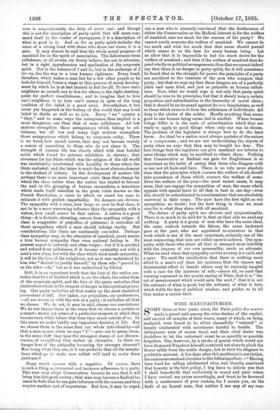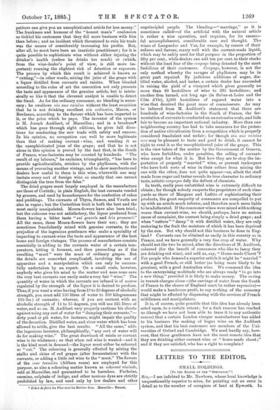WINE MANUFACTURING.
S011E three or four years since, the Paris police des 117.03Ur made a grand raid among the wine-dealers of the capital, arid carried off samples of their wares, many of which, on being analysed, were found to be either shamefully " watered " or largely adulterated with substances hurtful to health. The delinquents were of course fined, and their chief desire was doubtless to let the untoward event be as speedily as possible forgotten. One, however, by a stroke of genius which would not have disgraced Napoleon himself, contrived not alone to pluck the flower safely from the nettle danger, but to turn his disgrace to profitable account. A few days after this gentleman's conviction, his customers received circulars to the following effect:—" Having been fined for selling adulterated wine, and thereby convinced that honesty is the best policy, I beg leave to inform you that I shall henceforth deal exclusively in sound and pure wines. I have revised my prices accordingly, and trust to be favoured with a continuance of your custom, for I assure you, on the faith of an honest man, that neither I nor any of my own-
petitors can give you an unsophisticated article for less money." The frankness and humour of the "honest man's" confession so tickled his customers that they did more business with him than before ; and an incident which threatened to ruin his trade was the means of considerably increasing his profits. But, after all, he must have been an inartistic practitioner ; for it is quite possible to sophisticate wine without either injuring the drinker's health (unless he drinks too much) or (which, from the wine-dealer's point of view, is still more im- portant) running the slightest risk of detection or exposure. The process by which this result is achieved is known as 'cutting,"—in other words, mixing the juice of the grape with a liquor distilled from currants and raisins. When blended -according to the rules of art the concoction not only presents the taste and appearance of the genuine article, but is intrin- sically so like it that the cleverest analyst is unable to detect the fraud. As for the ordinary consumer, no blending is neces- sary; he swallows via any raisins without the least suspicion that he is not drinking excellent via ordinaire, Macon, or Bordeaux, according to the flavour which has been imparted to it, or the price which he pays. The inventor of the system is M. Joseph Audibert, of Marseilles ; and in a brochure* which has gone through eight editions, he gives full direc- tions for conducting the new trade with safety and success. In his opinion, no occupation can well be more legitimate than that of making currant - wine, anti vending it as the unsophisticated juice of the grape; and that he is not alone in this opinion is proved by the fact that, in the South of France, wine-factories may be counted by hundreds. "The result of my labours," he exclaims, triumphantly, "has been to provide agriculturalists, stricken by the phylloxera, with the means of procuring another vintage, and to show merchants and dealers how useful to them is this wine, wherewith one may imitate every sort of foreign wine so exactly that one cannot distinguish the true from the false:'
The dried grapes most largely employed in the manufacture are those of Corinth ; in plain English, the beat currants vended 13y grocers, and used by housekeepers for the confection of cakes and puddings. The currants of Thyra, Samos, and Vourla are also in vogue ; but the Corinthian fruit is both the best and the most easily manipulated. Moura-flowers have also been tried ; -bat the outcome was not satisfactory, the liquor produced from them having a bitter taste "sui generis and tAs prononai." All the same, these Mourn-flowers have their use ; they are sometimes fraudulently mixed with genuine currants, to the prejudice of the ingenious gentlemen who make a speciality of imparting to currant-wine the taste and appearance of the best home and foreign vintages. The process of manufacture consists essentially in adding to the currants water of a certain tem- perature, letting it ferment, and then proceeding as if the resulting "must" were the must of ordinary grapes. But the details are somewhat complicated, involving the use of apparatus and a manipulation which can only be success- fully undertaken by an expert. On a small scale, however, anybody who gives his mind to the matter and uses none save the very best currants can easily make a very fair "wine." The .quantity of water in which the currants are infused is of course regulated by the strength of the liquor it is desired to produce. Thas, if you want a wine having from 19 to 20 degrees of alcoholic -strength, you must add 150 litres of water to 100 kilogrammes 110 lbs ) of currants ; whereas, if you are content with an -alcoholic strength of 14 to 15 degrees, you will use 225 litres of water, and so on. M. Audibert very properly cautions his clients against using any sort of water for "damping their currants,"— 'dirty pond or pit water, for instance, might impair the quality of the decoction. Distilled water, and river water which has been allowed to settle, give the best results. "All the same," adds -the ingenious inventor, philosophically, "any sort of water will do for making wine." The great drawback of raisin or currant wine is its whiteness ; so that when red wine is wanted—and it is the kind most in demand—the liquor must either be coloured or"cut." The colouring is generally effected by mixing the stalks and skins of red grapes (after fermentation) with the currants, or adding a little red wine to the "must." The flowers of the rose tremiere (Althwa rosea) are employed for this purpose, as also a colouring matter known as colorant vinicole, sold at Marseilles, and guaranteed to be harmless. Fachaine, .carmine, sulphate of indigo, and other noxious dyes are strictly prohibited by law, and used only by low dealers and other • L'Artdefaire les Vine avec les Raisins Secs. Marseille; Domed. unprincipled people. The blending—" marriage," as it is sometimes called—of the artificial with the natural article is rather a nice operation, and requires, for its success- ful accomplishment, considerable care and thought. . The wines of Languedoc and Var, for example, by reason of their redness and flavour, marry well with the currant-made liquid, which may be safely used for that purpose in the proportion of fifty per cent., while dealers can add ten per cent, to their stocks without the least fear of the coupage being detected by the most fastidious of their customers. Coupage, however, is not the only method whereby the ravages of phylloxera may be in great part repaired. By judicious additions of sugar, dis- tilled water, alcohol, and tartar, a certain dealer has succeeded in raising the yield of a vineyard which gives generally no more than 60 hectolitres of wine to 285 hectolitres ; and another firm turned, not long ago (in Sa6ne-et-Loire and the Cate d'Or), 2,000 hectolitres of sugared water into a wine that deceived the great mass of connoisseurs. As may be inferred from M. Audibert's statement that there are hundreds of wine-factories in the South of France, the fer- mentation of currants is conducted on an extensive scale, and bids fair to become an important national industry. More than one neighbouring country has had to take measures for the protec- tion of native viticulturists from a competition which is properly considered fraudulent and unfair ; for though vin aux raisins secs may be pleasant to taste and good to drink, it cannot be right to vend it as the unsophisticated juice of the grape. This is the view taken of the matter by the Government of Geneva, who have forbidden, under penalties, the selling of currant- wine except for what it is. But how they are to stop the im- portation of properly " married " wine, or prevent innkeepers who have both sorts of wine in their cellars from mixing the one with the other, does not quite appear—as, albeit the stuff made from sugar and tartar reveals its true character to ordinary tests, artistic coupages defy the deftest of chemists.
In truth, really pure unfortified wine is extremely difficult to obtain ; for though nobody suspects the proprietors of such vine- yards as those of Margaux and Lafitte of sophisticating their products, the great majority of consumers are compelled to put up with an article much inferior, and therefore much more liable to be adulterated. If the commoner wines were mixed with nothing worse than currant-wine, we should, perhaps, have no serious cause of complaint, the currant being simply a dried grape ; and when " cutters " " damp " it with distilled water, they are only restoring to the fruit the moisture of which it has been deprived by the sun. But why should not this business be done in Eng- land? Currants can be obtained as easily in this country as in France, and we have generally a very fine crop of Water. Why should not the two be mixed, after the directions of M. Audibert, coloured (for the benefit of consumers who like to fancy they are drinking red wine), and sold as, say, "Home-made Claret"? For people who demand a superior article it might be " married " with a good French, or still better (as being more likely to be genuine), with a good Australian wine. We commend the idea to the enterprising multitude who are always ready "to go into a new thing," provided it is likely to make money. The saving in transit-charges alone—(the carriage of water from the South of France to the shores of England must be rather expensive)— would make a handsome profit, to say nothing of the economy that might be effected by dispensing with the services of French middlemen and manipulators.
It is, of course, quite possible that this idea has already been acted upon, to a certain extent ; for a dark rumour has reached us (though we have not been able to trace it to any authentic source) that a certain London vinegar manufacturer has added to his business the making of bogus wine on the Audibert system, and that his best customers are members of the Uni- versities of Oxford and Cambridge. We need hardly say, how- ever, that those gentlemen have not the most remote idea that they are drinking either currant wine or "home-made claret ;" and if they are satisfied, who has a right to complain ?



































 Previous page
Previous page